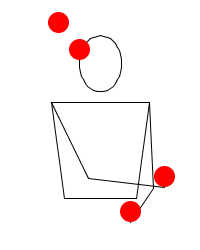Mills' Mess facts for kids
 |
|
| Minimum prop #: 3 | |
| Difficulty: 5/10, 3.9 (note: difficulty ratings are arbitrary and subject to change) | |
| Siteswap: 3 | |
| Shannon: 12 | |
| Period: 1 | |
| Parity: even or odd | |
| Notes: symmetrical, asynchronous |
Mills' Mess is a very popular juggling pattern. It is usually done with three balls. However, you can use different objects or even more balls. This trick was created by and named after Steve Mills.
Many jugglers know this trick well. Learning it is seen as a big step in becoming a better juggler. It looks like a "mind-boggling pattern of circling balls." Your hands cross and uncross, and the balls are caught in surprising ways.
The basic movement of Mills' Mess is like a reverse cascade. This is a common juggling pattern. But Mills' Mess adds a special "mess" by crossing and uncrossing your arms. This makes the balls seem to chase each other from one side to the other. It's also a windmill style pattern. This means the direction of the juggling changes every three throws.
Contents
How Mills' Mess Began
Mills' Mess was invented in the early 1970s, around 1974 or 1975. Steve Mills was trying out many new juggling ideas. He was inspired by what his teacher, Ron Graham, and others were doing in Central Park. Steve wanted to create a trick where both hands crossed. He got the idea from Ron Lubman.
Steve invented the trick while trying to smoothly switch between a right-handed windmill and a left-handed one. The trick got its name from other jugglers. This happened at the 1976 International Juggling Convention in Los Angeles, California. Steve Mills found it hard to teach this new pattern. When he tried to show it to skilled jugglers, they would shout, "This is a mess!" For several years, Steve didn't even know that people around the world were calling it "Mills Mess."
Fun Variations of Mills' Mess
You can combine Mills' Mess with other juggling moves. These include chops or claws. This makes the pattern a bit harder than a regular three-ball cascade. While most people use balls, you can also do Mills' Mess with rings, clubs, or even torches.
Jugglers have also performed Mills' Mess with more objects. There are versions with four, five, and even six or seven balls. You can also see it done with four, five, and six clubs.
Rubenstein's Revenge
Rubenstein's Revenge is a very fancy and changed version of Mills' Mess. It is one of the most famous variations of this trick.
Boston Mess
The Boston Mess is another type of Mills' Mess. In this trick, your arms still cross and uncross. But the balls are thrown straight up and down, like in columns. It is done with three balls.
Cherry Picking is a special version of the Boston Mess. In this trick, every time one hand catches a ball, it uses a claw grip.
Eric's Extension
Eric's Extension was invented by Eric Uhrhane. This Mills' Mess variation makes your arms cross twice on each side. The usual Mills' Mess only crosses once. These extra throws can make the pattern look even cooler.
To do Eric's Extension, your arms need to be thin or very flexible. This means some people might find it physically impossible. It is especially hard to do this trick with clubs.
Inside Out
When you add "chops" to the Mills' Mess pattern, it's sometimes called "Inside Out." A chop is when you sweep your hand downwards after catching a ball. When you do this with Mills' Mess, the chops alternate. They go from inside the pattern to outside the pattern.
This makes it look like the balls are almost juggling your hands! It creates an effect where the juggler seems to be quickly chasing the balls as they move. An American artist known as "The Great Bongo" gave this pattern its name. He also claims to have taught many jugglers "how to do it the easy way."
Siteswaps and Mills' Mess
Mills' Mess is a way to change the shape of a juggling pattern. It involves crossing and uncrossing your arms. This arm movement can be added to almost any siteswap pattern. A siteswap is a way to describe juggling patterns using numbers.
The standard Mills' Mess uses the siteswap 3. But jugglers have also done Mills' Mess with other siteswaps. These include 441, 531, and 534. You can also add the Mills' Mess shape to patterns like the three-ball 51 (the shower), 423, 414 (half box), 315, and 612 (see-saw). It can also be done with four-object patterns like 4 (columns or fountain), 534, and 552. Even the five-object cascade (siteswap 5) can have the Mills' Mess shape. The difficulty of adding the Mills' Mess shape varies for each pattern.


